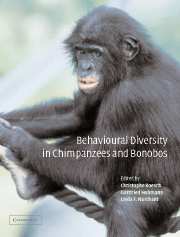Book contents
- Frontmatter
- Contents
- List of contributors
- Preface
- Behavioural Diversity in Pan
- PART I BEHAVIOURAL FLEXIBILITY
- PART II SOCIAL RELATIONS
- PART III FEMALE STRATEGIES
- PART IV HUNTING AND FOOD SHARING
- INTRODUCTION
- 16 Variations in chimpanzee–red colobus interactions
- 17 How bonobos handle hunts and harvests: why share food?
- 18 Hunting and meat sharing by chimpanzees at Ngogo, Kibale National Park, Uganda
- PART V GENETIC DIVERSITY
- Index
16 - Variations in chimpanzee–red colobus interactions
Published online by Cambridge University Press: 08 February 2010
- Frontmatter
- Contents
- List of contributors
- Preface
- Behavioural Diversity in Pan
- PART I BEHAVIOURAL FLEXIBILITY
- PART II SOCIAL RELATIONS
- PART III FEMALE STRATEGIES
- PART IV HUNTING AND FOOD SHARING
- INTRODUCTION
- 16 Variations in chimpanzee–red colobus interactions
- 17 How bonobos handle hunts and harvests: why share food?
- 18 Hunting and meat sharing by chimpanzees at Ngogo, Kibale National Park, Uganda
- PART V GENETIC DIVERSITY
- Index
Summary
INTRODUCTION
Predator–teractions are expected to be dynamic, as the outcome of each interaction depends upon the reactions of the two species and the contextual circumstances. Comparisons of the hunting behaviour of lions living in different environments revealed that selection of prey and hunting success was affected not only by the density of available cover but also by the density of potential prey (Van Orsdol 1984; Packer et al. 1990; Stander 1992). Studies on wild dogs have shown that hunting behaviour is affected by the ecological conditions under which the hunt occurred (Creel & Creel 1995). Similarly, fish modified their hunting behavior depending upon their hunger level as well as the available cover (Milinski 1975). Accordingly, empirical evidence supports the expectations that predator–teractions vary under the influence of different factors, including the behaviour of both opponents, as well as the prevailing spatial conditions. These interactions may also vary over time since species density as well as other environmental factors may vary.
The chimpanzee (Pan troglodytes) is an ideal species in which to examine these interactions, as all well-studied populations have been reported as hunting mammals for meat (Boesch & Boesch-Achermann 2000; Goodall 1986; Uehara et al. 1992; Uehara 1997; Mitani & Watts 1999). In addition, in every long-term study site where red colobus monkeys (Colobus badius) are sympatric with chimpanzees, that is, Mahale and Gombe in Tanzania, Kanyawara and Ngogo of Kibale in Uganda (all in East Africa), and Taï in Côte d'Ivoire (West Africa) this species is the most common prey.
- Type
- Chapter
- Information
- Behavioural Diversity in Chimpanzees and Bonobos , pp. 221 - 230Publisher: Cambridge University PressPrint publication year: 2002
- 12
- Cited by

